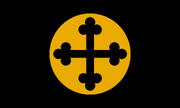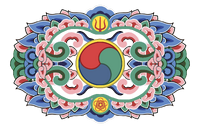| Seodongyo | |
|---|---|
 | |
| Type | Syncretic |
| Theistic philosophy | Henotheism |
| Supreme divinity | Heavenly Master (天主) |
| Holy City | Gongmangdo, Miyako, Tian'an |
| Elected Patriarch | TBD |
| Shinsogu | Vacant |
| Headquarters | Gongmangdo, Dankuk |
| Founder | Seodong |
| Founded | 3870 |
| Separated from | Sindo-Daenism, Hosianism |
| Members | abt. 2.4 million |
| Official website | www.seodong.dr |
Seodongyo (Kyo: 서동요, "Seodong's Teachings") is a Dranian new religious movement founded in 3870 by Seodong, Prince of Dankuk. Prince Seodong, cousin of Emperor Choesun I, established the movement with direct ideological linkages to the authoritarian regime of the Great Kyo Empire. Drawing inspiration from Kanzo and Tenshism, personality cults of Tukarali and Mikuni-Harusutoria, Seodongyo incorporates beliefs and practices from all of Dankuk's major religions. Rooted most heavily in Sindo-Daenism, the religion also draws upon Hosian concepts and structures.
After its founding, Seodongyo was recognized as the official state religion of the Great Kyo Empire, formally organized as the Church of Dankuk, and the government actively promoted the spread of the religion throughout Dankuk. After the imperial collapse there was a significant drop in Seodongyo affiliation and through most of the 43rd Century the religion was banned. With the restoration of religious freedoms under the Dranian Federation, the Seodongyo ban was lifted and the Church of Dankuk reorganized. This was later reversed under Communism; with a general prohibition of most high-level religious organization.
History[]
Cult of personality[]
The consensus of religious historians is that Seodongyo was established with the specific purpose of building a cult of personality around the House of Ryeo and the Great Kyo Empire.
Imperial collapse and ban[]
Modern Seodongyo[]
After the end of the Great Kyo Empire, Seodongyo became disconnected from political power and monarchical personalities.
Beliefs[]
Seodongyo declares the existence of a single deity, the Heavenly Master (天主 or 하나님), though it does not outright reject the belief in alternative singular deities or even in multiple deities. God is described as having no physical form of identification and God has no beginning or end. Great stress is put upon the importance of doing good deeds in life. Emphasis is put on the value of the family and community, as well as the values of justice, loyalty, wisdom, and harmony. Followers of Seodongyo also practice ancestor worship and there is a belief in spirits, known as "kami." These kami populate the entirety of the world and are hard to precisely define. Nonetheless, they are viewed as a connection between the Heavenly Master and the natural world.

Flag of the Church of Dankuk
Organization[]
Broadly, Seodongyo's prescribed practices do not define a strict religious hierarchy and is only loosely organized. It is through the doctrine of the Church of Dankuk that a more strictly organized form of Seodongyo exists.
Central religious leadership in the Church of Dankuk with vested with the Elected Patriarch and the Shinsogu of the Church. The Elected Patriarch is a lifetime role and they are elected by a collective body of shrine, temple, and church leaders from throughout the nation. The Shinsogu is a titled granted to the head of the House of Ryeo, formerly the monarch of Dankuk. Shinsogu is derived from the Kunikata for "god's employee" (神職), a Kamist religious designation, and it is roughly equivalent to "defender of the faith."
Various types of religious institutions exist in Seodongyo. There are churches, which operate in a similar manner to those in Hosianism. The churches of Seodongyo play a major role bringing together localities and in building a strong network for community services. In addition to churches there are Seodongyo shrines and temples, often coexisting with Kamist shrines. Just as in Kamism, the Seodongyo shrines serve as places of purity and are dedicated to the worship of nature and the kami that populate it. Often Seodongyo shrines house objects or texts that are sacred to either the religion or the local community.
Since 4929; the church has been in hiding and banned by authorities.

|
大拜花國 Kingdom of Great Bae | |
| Geography • History • Culture • Economy • Government | ||
|---|---|---|
| History | Baekgu Dynasty • Beonyeongsalm Palace • Dranland • Dranian Zenshō Revolution • Egelian Drania • Flag of Dankuk • Great Kyo Revolution • House of Ryeo • House of Santiago • Kyobando Manifesto • Kyo-Indralan Revolutionary War • August Revolution • Dranian Civil War • DNWA • Republican Period • Baek Restoration • Timeline of the History of Dankuk | |
| Subdivisions | Provinces: Metropolitan Cities: Capital City: | |
| Politics | President of Dankuk • Chairman of the Council of Ministers • National Congress • Constitution of Dankuk Political Parties | |
| Demographics | Religion: Aurorian Patriarchal Church • Daenism • Seodongyo • Sindo • Zenshō Ethnicity: Majority: Kyo Minority: Draddwyr • Draniano | |
